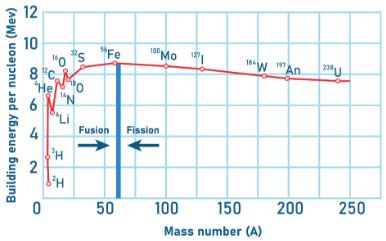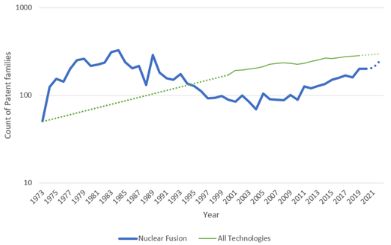- within Media, Telecoms, IT, Entertainment and Technology topic(s)
- with readers working within the Media & Information and Pharmaceuticals & BioTech industries
Nuclear fusion is the process whereby two smaller atomic nuclei combine to form a larger nucleus. It is the opposite of fission whereby a larger nucleus splits into the two smaller ones. In each case energy is released. This release of energy is based on Einstein's principle of mass-energy equivalence (the famous E = mc2). In each case, there is a reduction of mass. A small change in mass is converted into a large release of energy. The energy released through nuclear fusion (e.g. a hydrogen bomb) is greater than the amount released in nuclear fission (e.g. the bomb released over Hiroshima in 1945).
Nuclear fusion only releases energy when the element is lighter than iron. The average binding energy per nucleon increases with atomic weight up to that of iron and falls thereafter with larger and larger atoms (see graph). Elements lighter than iron tend to fuse into larger elements. Those heavier than iron tend to split into smaller elements. Iron is considered the dead-end when it comes to nuclear fusion. This is why iron [Fe] is the final element produced in a collapsing star.

To put into perspective how much energy is being released in a fusion reaction, it takes four hydrogen atoms to form a single helium atom. The difference in mass in this reaction is 0.02862 atomic mass units. This mass change is extremely small, and the energy release (4.3 x 10-12J) is also very small. But Avogadro's constant is enormous. One gram of matter contains 6.02 x 1023 atomic mass units. Just 4 grammes of hydrogen being converted into helium would result in an energy release of 2.6 x 108kj - enough to keep a 60-watt lightbulb powered for over a century.
If a fusion reaction could be controlled in a manner similar to a conventional nuclear fission reactor, a very a small amount of fuel could generate a large amount of energy and such a proposition could provide a secure source of energy for generations to come with no greenhouse gas emissions. These reactions take place in a tokamak. A tokamak is a machine in which fusion reactions can take place with the use of hot plasma.
Moreover, unlike uranium fission or plutonium fission, nuclear fusion does not generate heavy radioactive waste byproducts. These prospects - (i) CO2-free energy from (ii) readily available light elements such as hydrogen or lithium with (iii) no radioactive waste – make fusion a very attractive prospect for the world's future energy needs. But there is a very big snag.
Nuclear fusion occurs naturally in the Sun and is the fuel reaction that drives the Sun's heat. In the Sun, nuclear fusion occurs at 150,000,000°C, and therein lies the challenge of harnessing this source of energy on Earth. Any earthly material will instantly vaporize at such heat. Creating and containing such a temperature on Earth is a major engineering challenge.
But with scientific breakthroughs and technological advancements occurring at rapid rates, we are getting ever closer to establishing commercial nuclear fusion reactors.
It takes a lot of energy to achieve the high temperatures needed for fusion. In December 2022, the Lawrence Livermore National Laboratory's (LLNL) in the US was the first to create more energy from fusion than the energy used to start the reaction. It has been described as "one of the most impressive scientific feats of the 21st century." The LLNL experiment used lasers to achieve very high, very brief, and very localized heat. An alternative approach is to maintain the required temperature at a constant level in a plasma and to contain it in a very high magnetic field, such that the plasma never touches the sides of its containment vessel. This is the approach pursued by the Joint European Torus (JET) project in Oxfordshire, UK and at ITER in Southern France.
JET was built on a tokamak design, and in 1997 it produced 16 MW of fusion power while injecting 24 MW of thermal power to heat the fuel – not quite breakeven, but two-thirds of the way there.
In October 2022, the UK Government announced that West Burton power station site in Nottinghamshire will be the home for the UK's next prototype fusion energy plant, and on 8 November 2023, Andrew Bowie, the UK Minister for Nuclear and Networks signed a partnership deal with the US government to accelerate global fusion energy development. On 5 December 2023, the EU and Japan inaugurated a successor to ITER in the form of a six-storey-high machine in Naka, north of Tokyo.
Patent activity
During the third quarter of the 20th century there was a boom in the number of patents being filed in the field of nuclear fusion reactors. The excitement was led by Japan, with multiple Japanese companies filing hundreds of patent applications throughout the 70s and 80s. This was short lived. By the 21st century the numbers had decreased significantly, and Japanese players dropped out and China, Russia and the UK lead the way.

The Nuclear Fusion patents were patents classified under G21B
With countries racing to be the first to commercialise nuclear fusion, the number of patents being filed in regard to nuclear fusion technology has been increasing in the last couple of decades. The leaders in this field are China, USA, and Japan. For a while, the UK could be seen to be behind in the quantity of patents it was filing in the field of nuclear fusion.
Patent filings for nuclear fission and nuclear reactors in general show a similar pattern, but for every patent application filed for fusion, around ten are filed for fission.
There has been strong growth in patent filings across all technologies. Compared with the general trend, fusion and indeed fission are now beginning to catch up. We will not have complete numbers for 2022 until mid-2024 (when 18 months have passed).
A study published by Astamuse, ranks countries that have filed for patents in the field of nuclear fusion. The score for each country takes multiple factors into account (using 1,133 patents that were filed between 2011 and September 2022). Some of these factors included:
- The number of patents filed.
- The feasibility of each innovation.
- The remaining period of exclusivity.
With this scoring system, the UK ranked 3rd in the world (behind China and USA).
One of the companies at the forefront of UK patents in the UK nuclear fusion field is Tokamak Energy. As of 2023, Tokamak Energy has over 75 families of patent applications. They are notable for spherical tokamaks and high temperature superconducting magnets. Their technology is reported to achieve a 100,000,000°C plasma ion temperature. This temperature is considered the threshold for commercial fusion.
Another organisation at the forefront of the UKs development in nuclear fusion is the UK Atomic Energy Authority (UKAEA). They are currently the largest fusion organisation in the world, employing many leading scientists in the field. Ideas for which patents are pending range from developing faster methods of building the bioshield that surrounds the reactor, to techniques for extracting the helium required for supercooling.
The future looks promising for the UK when it comes to the commercialization of nuclear fusion. Tokamak Energy plans to have a prototype that can deliver electricity to the grid by 2030. There is much to be excited about when it comes to the progress of nuclear fusion energy.
Websites used as sources:
iRunway Research - Fusion Global Patent Landscape.pdf (energy.gov)
China tops nuclear fusion patent ranking, beating U.S. - Nikkei Asia
Advanced nuclear power (publishing.service.gov.uk)
Patents and the energy transition (windows.net)
The content of this article is intended to provide a general guide to the subject matter. Specialist advice should be sought about your specific circumstances.


